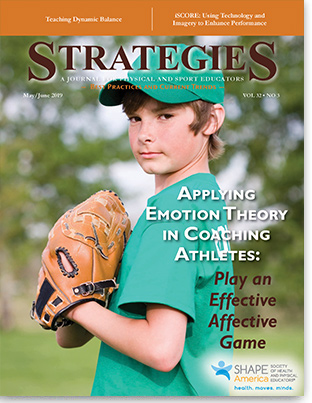 Strategies Table of Contents
Strategies Table of Contents
Applying Emotion Theory in Coaching Athletes: Play an Effective Affective Game
Graeme J. Connolly

In the classic sports movie, A League of Their Own (Abbott & Marshall, 1992), Jimmy Dugan (played by Tom Hanks) is tasked with managing the Rockford Peaches team, which is participating in the newly formed Women’s Baseball Association League. During one memorable scene, Coach Dugan barks at Evelyn, “There’s no crying in baseball.” Well, there is in fact crying (emotion) in baseball, and every other sport, as drama and challenges are an integral part of athletic competition. In an ensuing scene, Coach Dugan is ready to again tear into Evelyn but decides not to do so. He curbs his emotions and talks to her with more restraint, resulting in her controlling her emotions and improving her game play. Indeed, there are numerous scenes throughout the movie that depict emotional control (or lack of control) and growth, which illustrates the powerful positive (enhancing) or negative (impairing) infl uence that emotions can have on athletic performance. Th is uplifting and inspiring story is, in fact, a great example of applying specific principles of psychology and emotion theory to the coaching process. More specifically, the work of Hanin (1978, 1995, 2000a) and his individual zones of optimal functioning (IZOF) model are reflected in the movie and form the basis for this article. By exploring and developing a better understanding of the IZOF model and its applications, coaches (particularly those at the middle school and youth-sport level) can add to and enhance their “coaching toolbox” and ultimately improve their practice.
In his book entitled Applying Educational Psychology in Coaching Athletes, Huber (2013) examined the emotional athlete and the interesting interaction between emotions and performance. This article will focus on the theoretical underpinnings and associated practical applications of the IZOF model by utilizing carefully selected principles and concepts from Huber. This will help to simplify how coaches can teach athletes to use enhancing emotions, elude impairing emotions, sustain an optimal range of emotional functioning, and achieve elevated performance when it matters most.
The article begins by clearly defining the term emotion (within the context of athletic competition) and introducing the fascinating interplay between emotions and athletic performance. It then provides a brief overview of the IZOF model and the framework on which it is based. The article concludes by offering some preventive and coping strategies you can apply as a coach to help your athletes control their range of emotions, maximize their performance, and more successfully address the emotion–performance equation, particularly in youth sport settings.
To read the rest of this article, click here to download a pdf.